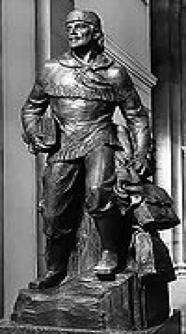
I bumped into Dr. Marcus Whitman on three separate occasions over a period of ten years. The latest was in February of 2009 during a tour of our Nation’s Capitol Building. Each meeting was unexpected and a pleasant surprise and each time I learn more about this man and the religious life he lived. He and his wife, Narcissa Prentiss, were brave soles during the early part of the 19th Century. They endured years of hardship and finally sacrificed their lives in an effort to bring the Gospel of Jesus Christ to the Indians in the Northwest Territory. Their story should be an inspiration of us all.
The first time I heard of Dr. Whitman was while vacationing in upstate New York. Friends suggested that we all drive to a little town called Prattsburg about 15 miles west of Penn Yan to listen to a program put on by local musicians. The program happened to be in the back yard of the old frame house of Narcissa Prentiss, a local celebrity. In the front yard was a historical marker which read: “Prentiss House – birth place of Narcissa Prentiss who later married Dr. Marcus Whitman. Together they crossed the Rockies to Oregon and established a mission.” As I later discovered, Dr. Whitman was a practicing physician who had offered his services to the American Board of Commissioner for Foreign Missions. The Board sent Marcus to investigate the possibilities of establishing missions in the Oregon country, then occupied by the United States and Great Britain. He returned to New York after his long journey with a favorable report. He then started looking for missionary recruits. This is when he met Narcissa who was a teacher of physics and chemistry and who was eager to travel west as a missionary, but had been unable to do so as a single woman. They were married on February 18, 1836 and together started out overland for the Northwest. We are told that Narcissa was the first white women to cross the Rockies following what was later called the Oregon Trail. Upon arriving at Fort Walla Walla, Washington, Marcus and Narcissa decided to establish a mission there among the Cayuse Indians.
In 2003 while tracing the historic route of Lewis and Clark, my wife and I stopped in Walla Walla at the Whitman National Historical Site. There in the old mission museum where wax figures of Marcus and Narcissa. Here we also learned that in the winter of 1842/43 Dr. Whitman returned to Boston on horseback to protest the Mission Board’s directive to abandon their unsuccessful efforts to Christianize the Indians. The authorities were persuaded to allow the Whitmans a second chance and in 1843 Marcus returned after traveling 6,000 miles. Some time later an epidemic of measles broke out among the Cayuse Tribe brought by the arrival of the white settlers traveling on the Oregon Trail. Dr. Whitman treated both the white children and Indians, but because the Native Americans lacked immunity to the disease the white children recovered while the Indians died. The Indians suspected that Dr. Whitman was practicing sorcery in order to make way for the white settlers. It was the Indian tradition of holding medicine men personally responsible for the patient's recovery which led the Indians to attack the mission on November, 29, 1847, killing 14 including the Whitmans.
The third occasion was when I literally bumped into Dr. Marcus Whitman. I was touring the National Statuary Hall in Washington DC and as I was following the tour guide, I backed into his life-sized statue. It had been placed there by the State of Washington in 1953. The Washington State Legislature has declared the fourth day of September as Marcus Whitman Day. It should be noted that news of the Cayuse attack on the Whitman mission triggering a long, savage war between Indians and whites in the Oregon Territory. When news of this war reached Congress, more Federal troops where sent there. This action eventually led the British to abandon their claim to the Oregon Territory.
